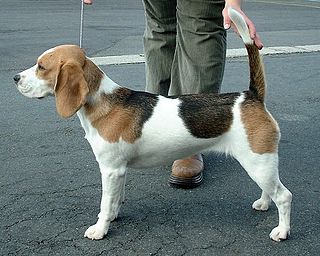
The beagle is a breed of small scent hound, similar in appearance to the much larger foxhound. The beagle was developed primarily for hunting hare, known as beagling. Possessing a great sense of smell and superior tracking instincts, the beagle is the primary breed used as a detection dog for prohibited agricultural imports and foodstuffs in quarantine around the world. The beagle is a popular pet due to its size and good temper.

The Harrier is a medium-sized dog breed of the hound class, used for hunting hares by trailing them. It resembles an English Foxhound but is slightly smaller, though not as small as a Beagle. The breed has been used since the mid 13th century.
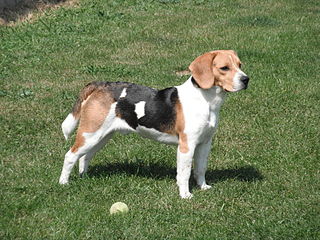
Scent hounds are a type of hound that primarily hunts by scent rather than sight. These breeds are hunting dogs and are generally regarded as having some of the most sensitive noses among dogs. Scent hounds specialize in following scent or smells. Most of them tend to have long, drooping ears and large nasal cavities to enhance smell sensitivity. They need to have relatively high endurance to be able to keep track of scent over long distances and rough terrain. It is believed that they were first bred by the Celts by crossbreeding mastiff-type dogs with sighthounds. The first established scent hounds were St. Hubert Hounds bred by monks in Belgium during the Middle Ages.
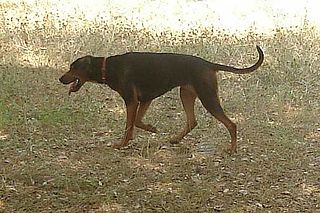
The Serbian Hound, previously known as the Balkan Hound, is a breed of scent hound from Serbia.
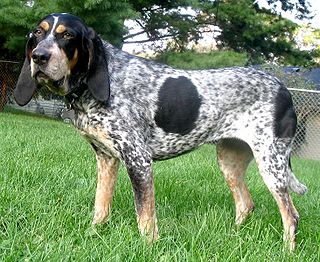
The Bluetick Coonhound is a breed of coonhound originating in the United States. The Bluetick Coonhound is known for its friendly personality, cold nose, and deep bawl mouth. It is most commonly used as a raccoon hunting dog, but is also kept as a pet.

The Alpine Dachsbracke is a small breed of dog of the scent hound type originating in Austria. The Alpine Dachsbracke was bred to track wounded deer as well as boar, hare, and fox. It is highly efficient at following a trail even after it has gone cold. The Alpine Dachsbracke is very sturdy.
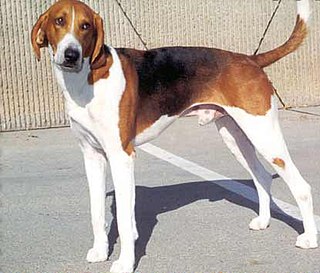
The American Foxhound is a breed of dog, closely related to the English Foxhound. They are scent hounds, bred to hunt foxes by scent. United States Founding Father George Washington was key to the breed's early development.
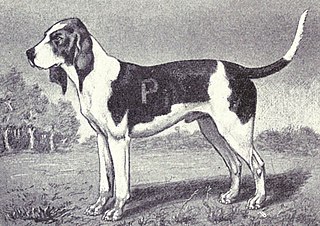
The Artois Hound or Chien D'Artois is a medium-sized breed of dog. A scent hound, the Artois was breed in northern France as a pack hunter. It is a rare breed today, but was popular in France before the 20th century. The breed was heavily crossbred and had to be reconstructed in the 1970s to more closely resemble the historical breed.
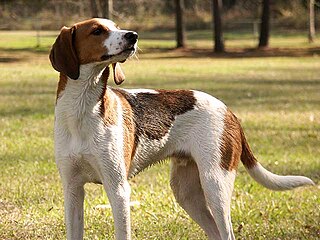
The Treeing Walker Coonhound is a breed of hound descended from the English and American Foxhounds. The breed originated in the United States when a stolen dog known as "Tennessee Lead" was crossed into the Walker Hound in the 19th century. The Treeing Walker Coonhound was recognized officially as a breed by the United Kennel Club in 1945 and by the American Kennel Club in 2012.

The Bavarian Mountain Hound is a breed of dog from Germany. As a scent hound, it has been used in Germany since the early 20th century to trail wounded game.
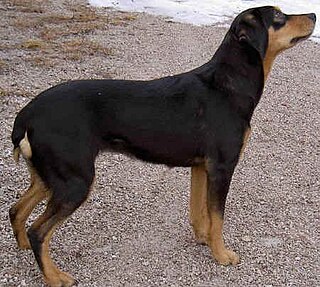
Smaland Hound is a breed of dog that originated in Sweden in the 16th century. Thought to be the oldest scent hound breed native to Sweden, it was first recognized by the Swedish Kennel Club in 1921. They are the smallest of the Swedish hound breeds, and have black and tan markings similar to the rottweiler. Internationally, it is recognized by a number of kennel clubs and registries including the Fédération Cynologique Internationale and United Kennel Club. It is considered rare, even in its native Sweden where only around sixty puppies are registered each year.
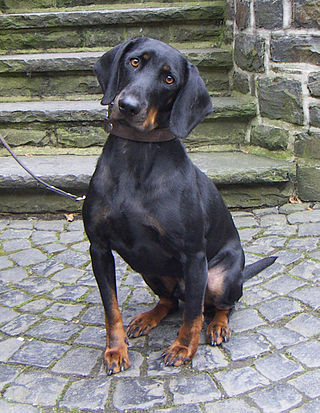
The Austrian Black and Tan Hound is a medium sized scenthound originating in Austria and is used for tracking wounded game, most commonly hare, in high altitudes.
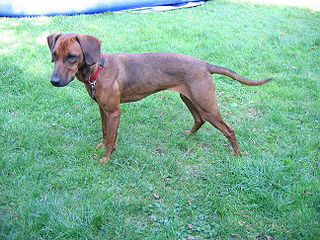
The Tyrolean Hound is a breed of dog that originated in Tyrol also called the Tiroler Bracke or Tyroler Bracke. They are scent hounds that descended from the Celtic hounds in the late 1800s, mainly for their hunting skills. They are hardworking, passionate, and independent dogs not known for their size, but rather their intelligence. For that reason, hunters can regularly use these dogs to catch their prey, wounded or otherwise. Their ability to stretch over long distances, on rough hot or cold terrain for their prey is also another perk of keeping this dog by your side. Hunters do have to worry about injuries to their dog, however, along with the common injuries that these dogs obtain throughout their life, like hip dysplasia or ear infections. Barring any injuries, these dogs tend to live an energetic life for about 12-14 years, and tend to be an overall healthy and robust dog.

The Kerry Beagle is the only extant scent hound breed native to Ireland.
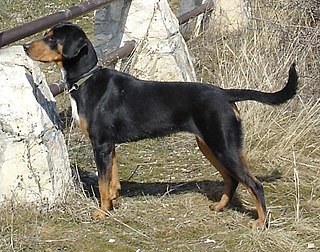
The Transylvanian Hound, also known as the Transylvanian Scent Hound or Hungarian Hound, is a Hungarian breed of scent hound used primarily for hunting. It originated in the former Kingdom of Hungary in the historical region of Transylvania, which is now part of Romania. It is strong and of medium size, characterized by a black body with tan and sometimes white markings on the muzzle, chest and extremities, and distinctive tan eyebrow spots. It has a high-pitched bark for a dog of its size. The breed was rescued from extinction by focused breeding efforts in the late twentieth century. There were formerly two varieties, the tall and the short, developed for different kinds of hunting in the Middle Ages. Only the tall variety survives today.
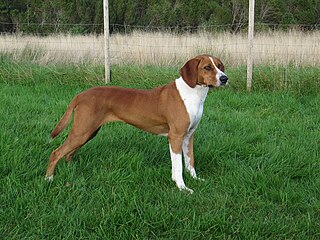
A Hygen Hound (Hygenhund) is a Norwegian breed of dog from the hound group, created in the 19th century by Norwegian breeder Hygen from various other hound breeds. The Hygen Hound is an endurance hunter who can traverse Arctic terrain for long periods of time without fatigue.
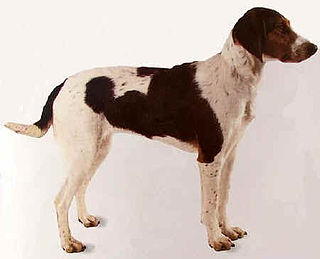
The Halden Hound, is a medium-sized Norwegian dog breed of the hound class, used for hunting hares and other plains quarry. It resembles an American Foxhound but is smaller. It was named after Halden, a town in southeastern Norway.

The Greek Harehound is a rare breed of dog that only comes in a black and tan color, originally bred as a scenthound for tracking and chasing hare in Southern Greece.

The Greek Shepherd or Greek Sheepdog is a breed of livestock guardian dog from Greece. Thought to be ancient in origin, the Greek Shepherd is very closely related to livestock guardian dog breeds from neighbouring countries; it is believed that some dogs are simultaneously claimed to be other breeds as they migrate annually across national borders with the flocks they protect in search seasonal pastures.
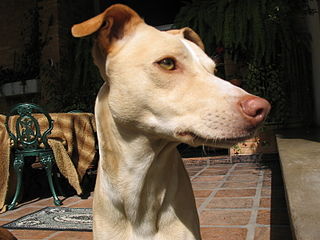
Pampas Deerhound is a Brazilian breed of hunting dog; it is also found in Argentina and Uruguay. It is common in Brazil, where it was first recognized by a national kennel club. The dogs were used to track, capture, and hunt deer, and thus earned the name Pampas Deerhound. It is still a widely preferred hunting companion to track other animals, such as wild boars.




















